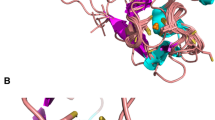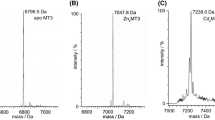Abstract
The circular dichroism was used to study the complexation of two isoforms of rabbit liver apo-metallothioneins (apo-MT1 and apo-MT2) with Cd2+ ion and the influence of Cd2+ ion on the conformation of reconstituted MTs. The stability of sulfhydryls of apo-MT has been investigated at the room temperature in the presence of air. The reconstitutions of apo-MT1 with Cd2+ ion were carried out atpH 4.71 (stable state) andpH 7.9 (with 90% sulfhydryls oxidated) respectively. it was found that the characteristic CD band at 257 nm(+), 238 nm(−), 226 nm(+) of reconstituted MT with Cd2+ ion was the same as native MT atpH 4.71, however only one peak at 243 nm(+) appeared on the CD spectra atpH 7.9 which arose from mononuclear complexes with four separated thiolate ligands per Cd2+ ion.
The CD spectra of apo-MTs+7 eq Cd2+ system were measured at variouspH values. It was found that the peak at 256 nm of apo-MT1 binding Cd2+ ion split into two small peaks atpH between 2.42 and 3.02, and became one peak atpH 3.32, while the shapes of Cd peaks of apo-MT2 binding Cd2+ ion did not change withpH, indicating that the binding sites and pathway of apo-MT1 binding Cd2+ ion were different from those of apo-MT2. A possible mechanism was suggested.
Zusammenfassung
Der Zirkulardichroismus wurde zur Untersuchung der Komplexierung zweier Isoformen von Leber apo-Metallothioneinen beim Hasen (apo-MT1 und apo-MT2) mit dem Cd2+-Ion und des Einflusses des Cd2+-Ions auf die Konformation von neukonstituierten MT. Die Stabilität der Sulfhydryle von apo-MT wurde bei Raumtemperatur in Gegenwart von Luft untersucht. Die Neukonstitutionen von apo-MT1 mit Cd2+-Ion wurde bei pH 4.71 (stabiler Zustand) undpH 7.9 (90% der Sulfhydryle oxidiert) durchgeführt. Man fand, daß die charakteristische CD-Bande bei 257 nm(+), 238 nm(−) und 226 nm(+) von neukonstituiertem MT mit Cd2+-Ion die gleiche war wie für natives MT beipH 4.71, und lediglich ein Peak bei 243 nm(+) trat im CD-Spektrum beipH 7.9 auf, der von mononuklearen Komplexen mit vier separierten Thiolatliganden pro Cd2+-Ion stammt.
Das CD-Spektrum des Systemes apo-MT+7 Äquiv. Cd2+ wurde bei verschiedenenpH-Werten vermessen. Man fand, daß der Peak bei 256 nm der Bindung von apo-MT1 an das Cd2+-Ion im Bereich vonpH 2.42 und 3.02 in zwei kleinere Peaks gespaltet wird und beipH 3.32 wieder zu einem Peak wird, während die Gestalt der CD-Peaks der Bindung von apo-MT2 an das Cd2+-IonpH-unabhängig ist, was darauf hinweist, daß die Bindungsstellen und-wege von apo-MT1 zur Bindung des Cd2+-Ions sich von denen von apo-MT2 unterscheiden. Ein möglicher Mechanismus wird vorgeschlagen.
Similar content being viewed by others
References
B. L. Vallee, Methods in Enzymology, 205 (1991) Part B, 3.
L. Bremner, Methods in Enzymology, 205 (1991) Part B, 25.
B. Zhang, W. Q. Wang, H. W. Ren, J. F. Lu and B. G. Ru, Acta Biophys. Sin., 8 (1992) 539.
M. Webb, Experientia Supplementum, 52 (1987) 109.
N. Akira, S. Masahiko and I. Nobumasa, Cancer Res., 47 (1987) 983.
J. H. R. Kägi, Metallothionein, a protein of all seasons, 3rd International Meeting on Metallothionein, Dec. 8–10, Tsukub, 1992.
D. Y. Chu, Y. Lin, R. L. Liu and B. G. Ru, Thermochim. Acta, 183 (1991) 57.
D. Y. Chu, W. G. He, R. L. Liu and B. G. Ru, Acta Biochim. Biophys. Sin. 26 (1994) 87.
G. L. Ellman, Arch. Biochem. Biophys., 82 (1959) 70.
A. Arseniev, P. Schultze, E. Woergeotter, W. Braum, G. Wangner, M. Vasak, J. H. R. Kaegi and K. Wuthrich, J. Mol. Biol. 201 (1988) 637.
A. H. Robbins, D. E. McRee, M. Williamson, S. A. Collett, N. H. Xuong, W. F. Furey, B. C. Wang and C. D. Stout, J. Mol. Biol., 221 (1991) 1269.
S. Andreas, Methods in Enzymology, 205 (1991) Part B, 535.
H. Willner, M. Vasak and J. H. R. kaegi, Biochemistry, 26 (1987) 6287.
M. Vašák, Methods in Enzymology, 205 (1991) Part B, 452.
J. H. R. Kägi and Y. Kojima, Experientia Suppl., 52 (1987) 25.
Author information
Authors and Affiliations
Rights and permissions
About this article
Cite this article
Chu, D., Lin, Y., Ru, B. et al. The complexation of apo-metallothionein with cadmium ion and its conformation study. Journal of Thermal Analysis 45, 17–26 (1995). https://doi.org/10.1007/BF02548658
Issue Date:
DOI: https://doi.org/10.1007/BF02548658




